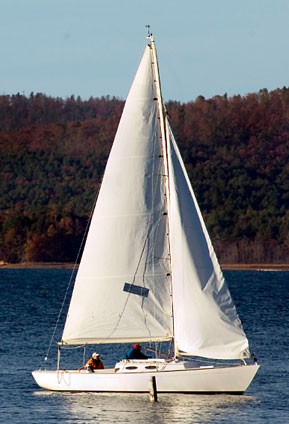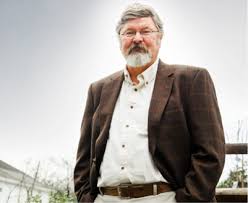
Adam Nicholson, author of “God’s Secretaries, The Making of the King James Bible” wrote a fine little book published by Harper Collins in 2004 entitled “Seamanship, a Voyage along the Wild Coasts of the British Isles”. The central story is rather pedestrian. Man meets Mid-Life Crisis. Man Gets Wife’s Permission To Dance With Said Crisis. Then Man buys a stout sailboat and embarks upon the rough seas that are a whole lot harder than his own nagging discontent. Despite the old formula, there are some sparkling human interactions in these quickly passing 177 pages. From the typical brutality of the sea and the emotions of two men cooped up on a boat from the coast of Cornwall to the Faeroes and all the little remote and rocky human outposts in between, one is struck by the essential fact that nature and the people of this world can still confront we moderns with the ethereal beauties of reality. When sailing, death and anguish are no mere abstractions.
Nicholson has you immediately on the “Auk” with him and when he stops at the monastic outposts perched magnificently at the former ends of the Western World, you intimately enjoy his time with the monks who are as otherworldly as their setting. But there is one random meeting that resonates and it is after a brutal storm near Port Magee on the rugged County Kerry Coast of Ireland. The chapter, fittingly, is entitled simply : “The Man” .
It seems that the authorities manage to save a fisherman and tow him into harbor, soaked to the bone within his little junkyard ark of ramshackle dishabille. The author, with his son and an old friend hired on as skipper see this seemingly desperate refugee in his sea-wrecked extremity and offer to cook the fellow some breakfast and dress him in warm clothes. They did not know that their charity would be so amply repaid. Aside from being a robust raconteur, the man, Herve Mahe, native of Breton, was a passionate philosopher and chef. After cooking them a remarkable lunch, Herve offers up a gargantuan truth that got me to thinking this Easter Week. He was directing his thoughts at the author’s son and the exchange is as follows:
“Adam, listen, no listen, you must listen………what is important in the relation of man to the world is the hand”.
Adam replies, “The Hand?”
“Yes the Hand!”
To underscore his point, he held up one of his greasy, diesel-soaked , calloused meathooks and then grabbed Nicholson’s wrist and held both hands aloft for the son to ponder.
“As long as the hand is the shaping organism of an enterprise, or a relationship, as long as it is the hand which governs your connections with the world, those connections are healthy, living and warm…..Technology! It is technology that is the great destroyer, which comes between the hand and the world, which interposes its own cold deadness between the heart and the world”.
Reading this, I put the book down for a moment and looked at my own hands, callouses gone soft over the winter, a scar or two tracing across the fingers and it brought to mind another set of hands from long ago. Housed within Herve’s paean to the hand of man is the loaded imagery of the crucifixion. It is no wonder that we fallen mortals would drive a heavy spike through the opened hands of Christ, bloodily impaling him atop the rocky pate of Golgotha. We would end his life with us first by bloodily binding his hands.
The world is always and forever within our hands, hands that can lovingly caress and firmly clasp in honest greeting or pull a trigger to deliver death. Our hands are uniquely suited to the technology we create but when we devise new technologies that distance us from the immediacy of our environment and friends or serve to obscure the importance of our hand and its relationship to our mind, we might just as well crucify ourselves on a cross of mechanical oblivion.
On our road to Emmaus, backwards into a more productive relationship on this good earth with both our fellow and all the life of a planet beautifully adorned, it is the Hand that will loom as large as anything we possess. Ten fingers that can facilitate our independence but that can also reach their greatest lengths when clasped in friendship and shared purpose. These hands of ours, accouterments to the mind, they are at once, a vehicle of liberty and service. How perverse and reckless they are when rolled in the vestigial stump of a fist. Open your hands and you shall stare deeply into the possibilities of the human mind. Clasp another’s hand and these possibilities become unending.





8 comments
Thomas McCullough
I got “Seamanship” from the library and read it. It wasn’t a waste of time, but the passage you quote is really the payoff.
Brad Evans
You do realize that if you crucified someone through the hands, he’d probably tear away from the wood/nails; hammering through the wrists is not only more painful but more likely to keep the victim up.
John Willson
Sabin,
“God’s Secretaries” is also a knockout book. I probably won’t read the one you talk about here, because you have ruined it by writing better than he possibly could. There was once a time when the Church considered honoring the handshake as a sacrament, which I still think is a pretty good idea. I remember the hands of of a woman at whose funeral I preached; she was 96 when she died, and had seen the world since 1898–what a burden! But she had the most beautiful hands, made to wear God’s jewelry and to make one’s cheek feel as if it were touched by His own hand.
D.W. Sabin
Thanks folks. As a point of clarification, the authors name is actually Nicolson (without the “h”).
Thomas, I have not yet done so…the old battle cry of “Procrastinate Now” is emblazoned on my dented helmet.
It is Easter and the Forsythia and Cornelian Cherry and Magnolia and Cherry Blossoms are busting out in New England and WHAT…could be better?
Thomas McCullough
A Good post. Thank you. I am really, really knocked out by the passage you quote.
Did you ever get around to posting your artwork as you once wrote you would be doing?
Cecelia
Thank you – perfect way to end Good Friday.
rex
D.W. Your essay is refreshingly humanist. After the last few weeks of posts I was about to suggest that the website’s theme: Place, Limits, Liberty, be replaced with: God’s Place, Christ’s Limits, and Jesus’ Liberty.
TY
Bob Cheeks
This is, of course, the DW Sabin post I have long awaited.
To your credit you’ve surpassed the immanent episteme of the academy and moved toward a primordial awareness of potential being driven by a anamnesis illuminated within the apperception of the psyche that intimately yearns for the divine/human encounter.
I worship a Jewish carpenter and it is Easter, He is Risen….there is salvation! (“…a disciple’s response to the drama of the Son of God as an event in the drama of revelation.”
Comments are closed.